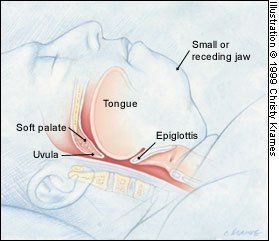The word apnea is Greek meaning “no breath.” There are three types of sleep apnea. The first, and most common, is obstructive sleep apnea (OSA) which is caused by an obstruction in the airway. The second is central sleep apnea where the brain fails to signal the muscles involved in breathing to function; and the third is mixed apnea, which is a combination of the two. We will address obstructive sleep apnea in this article.
So what is obstructive sleep apnea? When you’re awake, the muscles around your airway are stiff and keep your airways open so air can easily flow to your lungs. When asleep, these muscles relax and allow your airway to collapse or narrow and block the flow of air. When these muscles relax, the airway narrows and the air rushing through it vibrates, causing you to snore. This relaxing also reduces the amount of air entering the lungs and reduces the oxygen level in the blood. The reduced oxygen level triggers your brain to disturb your sleep causing you to awake tightening the muscles and restoring airflow. This cycle of apneic events may happen 20 to 60 times per hour reducing your ability to get the restorative sleep you need.
Normal airway. The soft palate and uvula are normal in length and total size. The tongue is normal in size and is angled forward. – Courtesy aafp.org
Figure 2
Abnormal airway during sleep. Multiple sites of obstruction often occur in patients with obstructive sleep apnea. – Courtesy aafp.org
Sleep apnea can be a dangerous condition if not treated. The frequent drops in oxygen triggers the production of stress hormones that raise your heart rate and increases your risk of heart attack, high blood pressure, stroke, obesity, impotence and diabetes. Just because you snore doesn’t mean you have sleep apnea. But if you have early morning headaches or excessive sleepiness during the day, your doctor should test you.
This 4 minute video contains some good information on sleep apnea. http://www.youtube.com/watch?v=bzjlaQWWnhU&feature=player_detailpage
What are the treatments for sleep apnea?

The first steps in correcting sleep apnea are lifestyle changes that you can make. Some tips are:
- Avoid alcohol and medicines that make you sleepy. These can help cause the muscles around your airway to relax.
- If you’re obese, loose weight.
- Nasal sprays or allergy medicines may help keep your airways open at night.
- Quit smoking.
- Sleep on your side instead of your back.
If these tips don’t help, your doctor can recommend the following treatments.
Breathing Devices
A CPAP (continuous positive airway pressure) system is a common treatment for severe to moderate sleep apnea. A CPAP system gently forces air into the throat through a mask that is worn at night. The air pressure helps keep the airways open and will restore a good nights sleep.
Mouthpieces
A mouthpiece or oral appliance is fitted by your dentist or orthodontist and is used to treat mild sleep apnea. The mouthpiece readjusts the lower jaw and tongue to help keep the airways open during sleep.
Surgery
Surgery is used to remove the tonsils, reset the lower jaw or remove or shrink excess tissue in the throat. This will help open the airways during sleep.
For more information on sleep apnea check out the following link:
